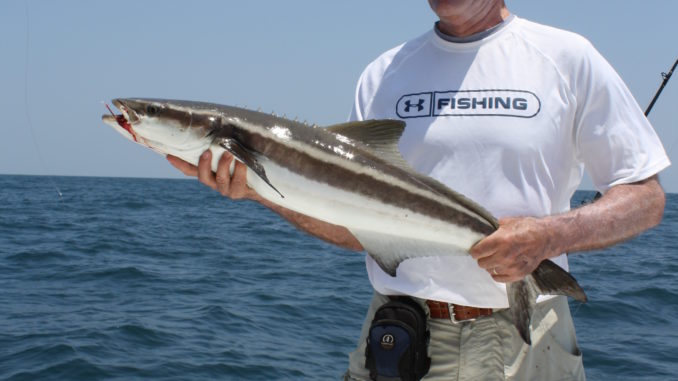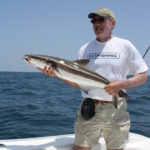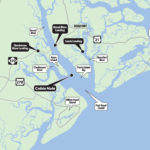
Beaufort area fishermen square off with spring battlers using three main techniques — all of them effective.
The Broad River and springtime cobia are subjects so intertwined that fishermen rarely reference one without mentioning the other. When conditions are right, it seems everyone with a boat is cruising around, scanning the surface or soaking their best baits on the bottom, hoping to hook-up with the bell of the ball, Miss Cobia.
Probably more anglers target and catch more cobia in the inshore and nearshore waters around Beaufort than anywhere else in the world during this short, May-June window of fast action.
Many fishermen believe cobia frequent the Broad River because its tidal characteristics provide ideal spawning conditions. The reason is less important than the fact that hundreds or thousands of these big, brown fish drift up the river, while armadas of vessels anchor up at the SC 170 bridge, the Cobia Hole and other favorite spots with their heavy tackle, presenting eels, live baitfish and cut bait, hoping for a hookup with a monster.
On those magic days when the water is slick, fishermen slowly cruise around, looking for the tell-tale signs of fish at or near the surface. When they spot one, they throw baits, lures and huge, feathered flies at the fish. Spotted fish are not easily spooked and often easily hooked, but then comes the tough part: landing them on light tackle. Cobia pull harder and fight longer than any other gamefish in the Lowcountry, with the possible exception of the infrequently targeted tarpon.
Cobia are targeted in three general ways: near the bottom with live or dead bait, on the surface with spinning gear and bait or lures and also sight-fishing with fly tackle.
Christian Sherbert, a Beaufort native, happened pretty much by accident onto a trick that turned one cobia near his boat into several — and in a few instances, up to 10 or 20. Always a light-tackle angler, he normally uses a 7-foot Shimano Compre spinning rod and a 2500 series Shimano Stradic reel loaded with 20-pound test PowerPro braid, which is indeed light gear for cobia. His approach is sight-casting; he actually uses a close-up technique, making a short, underhand pitch with a 4-inch D.O.A. shrimp in the clear/tan color or a Gulp! eel to about four feet in front of the cobia he has closed in on.
Sherbert is not a guide, but his regular job offers somewhat flexible hours, so he will fish a good tide on the spur of the moment. If he sees dead, calm water with the tide — either high or low — that is slack in the morning, he’ll hop in the boat and head for one of his favorite spots in the river. He focuses on drop-offs where the water depth changes from about 12 feet to maybe 30 feet deep, and he begins cruising around looking for signs of fish. The tip-off, a push in the water that he describes as a V-shaped wake similar to what a partially submerged crab buoy makes when the tide is running. When he sees one, often there will be another that he believes is a male following a female, possibly with romantic intentions.
Once he spots fish, he approaches at an angle until his boat is fairly close alongside the swimming fish. Once in range, he picks up the rod, splashes some menhaden oil onto his lure and makes a little flip-cast to the fish.
That’s where the “accident “ happened about eight years ago. In the excitement of the moment, he spilled menhaden oil into the river. He hooked the fish, but while he was fighting it to the boat, he noticed several other cobia swimming nearby, apparently attracted by the commotion or the menhaden oil — or maybe both.
That was the birth of a technique that has produced multiple hook-ups numerous times, and on at least three occasions, he has hooked and quickly released five or six 30- to 40-inch cobia in quick order. Nowadays, whenever he is working toward fish or fighting a fish, he will dribble a little menhaden oil into the water to create a slick around the boat. It works for him; why not try it?
Surprising as it must seem to those unfamiliar with the power and effectiveness of modern saltwater fly rods on even the largest fish, long-rodders catch lots of cobia, and virtually all of them are spotted before a cast is made. It’s sight-fishing at its best.
Cobia often cruise near the surface or laze around near floating debris and channel markers, and they will readily take a large fly placed near their nose. They are often not boat-shy, people-shy or shy in any other way.
Paul Burton, owner/partner of Bray’s Island Real Estate and a veteran fly angler, is a sight-fishing cobia specialist. “Cobia, as pelagic fish, are always on the move looking for food so I look for them anywhere from the trestle bridge to Bay Point,” he said. “On calm days, you can see them at great distances while in the chop you may only have seconds to make a cast.”
His strongest point is being ready every minute you’re on the water. That means even having line stripped off the reel and lying on the deck ready to cast instantly.
Burton uses a 12-weight rod with floating line and a 9-foot length of 40- to 60-pound test monofilament leader tied directly to a huge fly. He cruises at a gentle idle, faster when it is slick calm, trying to cover as much water as possible. In choppy conditions, he favors areas protected from the wind for greater visibility but doesn’t favor any particular honey holes, although fish tend to be near tide lines where bait accumulates.
When a fish is spotted, Burton maneuvers the boat so it is not moving directly at the fish, because he said, “The game is won or lost on the retrieve.
“Nobody can retrieve fast enough to make the fly move with the boat moving toward the fish, and the fly must move to entice a strike.”
He tries to slap down the fly, generally a large, weighted slider style, about four feet in front of the fish, and he wants the retrieve to move it in front of and away from the fish. Often, cobia will follow the fly right to the boat without striking.
“It’s a game of cat and mouse with cobia,” he said. “You need to illicit a strike.”
Sometimes, that means making multiple casts at a reticent fish.
“If the fish is just following, don’t wait until it gets to the boat,” he said. “Pick up and immediately cast again to one side of his nose or the other. You have to make him think the bait is getting away.”
Burton believes prime conditions are at the turning of the tides, but he said fish can be seen and caught in most any conditions. The most fish he has seen was 27 in a 2-day stretch of fishing, and 18 in one single day. It is possible to land multiple fish in a day, but he admits that one big one just about wears him out, and he has caught some big ones on the fly. His biggest was 55 pounds, but he has had bigger ones on.
Boating a huge cobia from the depths with heavy tackle is surely a thrill. Hooking and landing one that you see on the surface with a fly rod is awesome.
If you count the boats anchored in the Broad River or hovering over various nearshore wrecks, it is apparent that most anglers target cobia with heavy rods and bait on the bottom or suspended in the current, hoping to lure a passing fish into eating. They use heavy tackle for good reason, because these are bulldog fighters that can weigh 60 to 80 pounds and struggle for a long time before succumbing.
Anglers with small boats are confined to the river proper and often congregate at popular spots like the Cobia Hole or the Paris Island Rip, where it is not uncommon to have a dozen or more anchored against the flow with chum bags deployed and multiple lines played out to the rear. Popular baits include live eels, live menhaden or threadfin shad, squid, blue crabs and chunks of mullet. Though it is crowded, most anglers are courteous, and everyone gets excited when a rod bends under the strain of a big cobia, thinking that a cluster of fish is passing through and they may be next.
Anglers with access to an offshore boat often fish the wrecks for cobia, where action starts earlier and lasts longer into the season.
When Capt. Jason Dubose fishes wrecks for cobia in his 42-foot Lucky Hooker, his first stop is for live bait. Stopping at one of the bait-holding sand bars off Hilton Head near Dolphin Head, he tries to get both menhaden and threadfin shad when possible. Though it normally takes several, one cast of his huge net can sometimes bring up enough bait for a day at the wrecks.
Dubose’s favorite wrecks for cobia are the Betsy Ross, Eagle’s Nest and the Hilton Head Tire Reef. Once on site, thanks to accurate GPS numbers and bottom-sensing and side-sensing sonar, he figures the drift and wind before dropping anchor, hoping for a perfect swing over his spot. It’s then on to threading a live bait onto a big, 5/0 to 7/0 circle hook at the end of a Carolina rig featuring an 8-ounce egg sinker to take it to the bottom. Bounce the sinker on the bottom, and one or two cranks up puts the bait in the strike zone and makes it time to just wait for the tug. Setting the hook with a circle hook is a matter of holding on as the hook slides out of fish’s throat and lodges firmly in the corner of its mouth. Then, it’s just a tug-of-war cranking her home.
Dubose will gaff a legal fish that will be kept for dinner, but for fish that will be released, he lands them with a hand at the corner of their mouth, taking care not to damage their gill plates. He encourages his clients to kill only what they can reasonably eat, with a grip-and-grin photo being the permanent memory of the outing.
Experienced cobia fisherman warn newcomers that these are very powerful fish that sometimes come to the boat very easily, at least initially. When a fish that’s not thoroughly tired out — a “green” fish — is lifted into a boat, it can do great damage to equipment and occupants. They don’t bite like a shark, but they do thrash around violently, sending people jumping for safety and equipment flying. They can hurt you, so be careful. If you do catch a cobia, clean it carefully and be prepared for what many consider the most delectable tasting fish in the Lowcountry.
DESTINATION INFORMATION
HOW TO GET THERE — The Beaufort area is best accessed from I-95 and US 21. A popular landing is the Chechessee River Landing at the foot of the SC 170 Bridge, and the relatively new Broad River landing at the base of the Broad River Bridge. Several other landings offer access to the Broad River and Port Royal Sound, including the Sands Landing in Port Royal.
WHEN TO GO — Prime inshore cobia fishing begins toward the end of April and can last into June. The season is extended on either end if fishing nearshore reefs and wrecks is included. Sight-fishing is best done on the slack tides, either high or low, and when the wind in relatively calm. Fishing with bait can be done at any time. The limit for cobia is two per day, with a minimum length of more than 33 inches from nose to the fork of the tail.
FISHING INFO/GUIDES — Capt. Jason Dubose, 843-304-4834; Capt. Richard Sykes, 843-838-2245; Capt. Tuck Scott, 843-271-5406; Capt. Owen Plair, 843-81-3656; Capt. Jack Brown, 843-838-9369. See also Guides and Charters in Classifieds.
ACCOMMODATIONS — Beaufort Area Chamber of Commerce, 843-986-5400.
MAPS — Capt. Segull’s Nautical Charts, 888-473-4855, www.captainsegullcharts.com; S.C. Department of Natural Resources, www.dnr.sc.gov/marine/pub/seascience/reefloc.html.






Be the first to comment